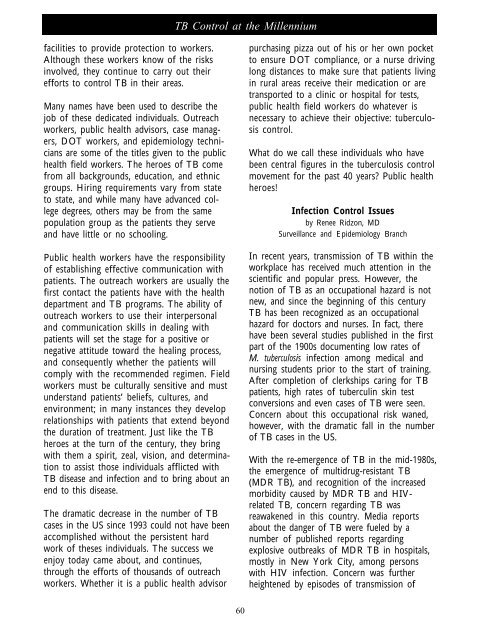CDC History of Tuberculosis Control - Medical and Public Health ...
CDC History of Tuberculosis Control - Medical and Public Health ...
CDC History of Tuberculosis Control - Medical and Public Health ...
You also want an ePaper? Increase the reach of your titles
YUMPU automatically turns print PDFs into web optimized ePapers that Google loves.
facilities to provide protection to workers.<br />
Although these workers know <strong>of</strong> the risks<br />
involved, they continue to carry out their<br />
efforts to control TB in their areas.<br />
Many names have been used to describe the<br />
job <strong>of</strong> these dedicated individuals. Outreach<br />
workers, public health advisors, case managers,<br />
DOT workers, <strong>and</strong> epidemiology technicians<br />
are some <strong>of</strong> the titles given to the public<br />
health field workers. The heroes <strong>of</strong> TB come<br />
from all backgrounds, education, <strong>and</strong> ethnic<br />
groups. Hiring requirements vary from state<br />
to state, <strong>and</strong> while many have advanced college<br />
degrees, others may be from the same<br />
population group as the patients they serve<br />
<strong>and</strong> have little or no schooling.<br />
<strong>Public</strong> health workers have the responsibility<br />
<strong>of</strong> establishing effective communication with<br />
patients. The outreach workers are usually the<br />
first contact the patients have with the health<br />
department <strong>and</strong> TB programs. The ability <strong>of</strong><br />
outreach workers to use their interpersonal<br />
<strong>and</strong> communication skills in dealing with<br />
patients will set the stage for a positive or<br />
negative attitude toward the healing process,<br />
<strong>and</strong> consequently whether the patients will<br />
comply with the recommended regimen. Field<br />
workers must be culturally sensitive <strong>and</strong> must<br />
underst<strong>and</strong> patients’ beliefs, cultures, <strong>and</strong><br />
environment; in many instances they develop<br />
relationships with patients that extend beyond<br />
the duration <strong>of</strong> treatment. Just like the TB<br />
heroes at the turn <strong>of</strong> the century, they bring<br />
with them a spirit, zeal, vision, <strong>and</strong> determination<br />
to assist those individuals afflicted with<br />
TB disease <strong>and</strong> infection <strong>and</strong> to bring about an<br />
end to this disease.<br />
The dramatic decrease in the number <strong>of</strong> TB<br />
cases in the US since 1993 could not have been<br />
accomplished without the persistent hard<br />
work <strong>of</strong> theses individuals. The success we<br />
enjoy today came about, <strong>and</strong> continues,<br />
through the efforts <strong>of</strong> thous<strong>and</strong>s <strong>of</strong> outreach<br />
workers. Whether it is a public health advisor<br />
TB <strong>Control</strong> at the Millennium<br />
60<br />
purchasing pizza out <strong>of</strong> his or her own pocket<br />
to ensure DOT compliance, or a nurse driving<br />
long distances to make sure that patients living<br />
in rural areas receive their medication or are<br />
transported to a clinic or hospital for tests,<br />
public health field workers do whatever is<br />
necessary to achieve their objective: tuberculosis<br />
control.<br />
What do we call these individuals who have<br />
been central figures in the tuberculosis control<br />
movement for the past 40 years? <strong>Public</strong> health<br />
heroes!<br />
Infection <strong>Control</strong> Issues<br />
by Renee Ridzon, MD<br />
Surveillance <strong>and</strong> Epidemiology Branch<br />
In recent years, transmission <strong>of</strong> TB within the<br />
workplace has received much attention in the<br />
scientific <strong>and</strong> popular press. However, the<br />
notion <strong>of</strong> TB as an occupational hazard is not<br />
new, <strong>and</strong> since the beginning <strong>of</strong> this century<br />
TB has been recognized as an occupational<br />
hazard for doctors <strong>and</strong> nurses. In fact, there<br />
have been several studies published in the first<br />
part <strong>of</strong> the 1900s documenting low rates <strong>of</strong><br />
M. tuberculosis infection among medical <strong>and</strong><br />
nursing students prior to the start <strong>of</strong> training.<br />
After completion <strong>of</strong> clerkships caring for TB<br />
patients, high rates <strong>of</strong> tuberculin skin test<br />
conversions <strong>and</strong> even cases <strong>of</strong> TB were seen.<br />
Concern about this occupational risk waned,<br />
however, with the dramatic fall in the number<br />
<strong>of</strong> TB cases in the US.<br />
With the re-emergence <strong>of</strong> TB in the mid-1980s,<br />
the emergence <strong>of</strong> multidrug-resistant TB<br />
(MDR TB), <strong>and</strong> recognition <strong>of</strong> the increased<br />
morbidity caused by MDR TB <strong>and</strong> HIVrelated<br />
TB, concern regarding TB was<br />
reawakened in this country. Media reports<br />
about the danger <strong>of</strong> TB were fueled by a<br />
number <strong>of</strong> published reports regarding<br />
explosive outbreaks <strong>of</strong> MDR TB in hospitals,<br />
mostly in New York City, among persons<br />
with HIV infection. Concern was further<br />
heightened by episodes <strong>of</strong> transmission <strong>of</strong>
















